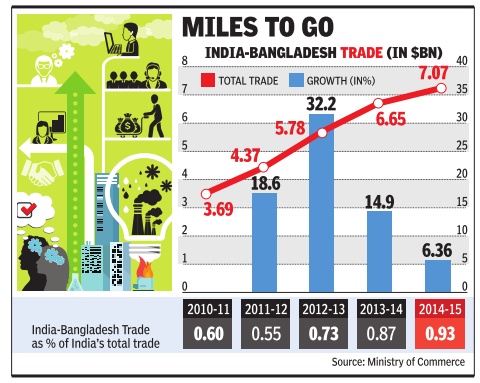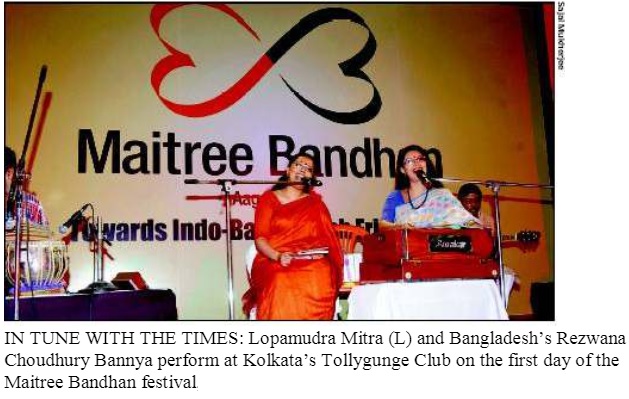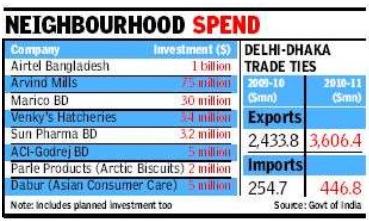Bangladesh- India relations
(Created page with "[[File: indo bangladesh trade.jpg|Indo Bangladesh trade, year-wise: 2010-15, Graphic courtesy: [http://epaperbeta.timesofindia.com//Article.aspx?eid=31808&articlexml=Great-Exp...") |
|||
| Line 12: | Line 12: | ||
[[Category:Foreign relations |B ]] | [[Category:Foreign relations |B ]] | ||
[[Category:Economy-Industry-Resources |B ]] | [[Category:Economy-Industry-Resources |B ]] | ||
| + | |||
| + | =India-Bangladesh trade= | ||
| + | [http://timesofindia.indiatimes.com/home/Delhi-Dhaka-on-trade-train/articleshow/12027901.cms ''The Times of India''], Feb 25, 2012 | ||
| + | |||
| + | [[File: Maitree Bandhan festival.jpg|Maitree Bandhan festival; Picture courtesy: [http://timesofindia.indiatimes.com/home/Delhi-Dhaka-on-trade-train/articleshow/12027901.cms ''The Times of India''], Feb 25, 2012|frame|500px]] | ||
| + | [[File: Indian firms in Bangladesh.jpg|Indian firms in Bangladesh; Graphic courtesy: [http://timesofindia.indiatimes.com/home/Delhi-Dhaka-on-trade-train/articleshow/12027901.cms ''The Times of India''], Feb 25, 2012|frame|500px]] | ||
| + | |||
| + | Sidhartha & Surojit Gupta | ||
| + | |||
| + | '''With over 100 Indian firms already in Bangladesh, and trade in current financial year already at $1.7bn, business relations between the two countries have never looked better''' | ||
| + | |||
| + | Kotak Mahindra Bank is the latest Indian firm to line up to be part of the growing India-Bangladesh trade and investment story. The private sector lender has sought permission from the authorities across the border to set up a joint venture with Abdul Mehtab Ahmed, a local businessman. A Kotak Mahindra spokesperson told ToI that the move is in line with the bank’s growth strategy. But any banking analyst would tell you that banks typically follow companies to meet their funding requirements. What they leverage is their existing ties. With over 100 Indian companies already in Bangladesh, it is not surprising that the country is on the banking radar. From Bharti Airtel, which has invested close to $1 billion, to the AV Birla Group, Arvind Mills and Sun Pharma and even smaller players who make fans, plastic products and garments, several Indian players are sensing an opportunity across the border. After all, trade ties have improved, which is evident in better trade numbers. In the first six months of the current financial year trade has increased to around $1.7 billion from $1.56 billion in April-September 2011. Although exports from India have increased marginally to $1.4 billion, imports have gone up 85% to $290 million from around $160 million a year ago. The target is to increase trade to $1 billion this year. “The terms of trade are still tilted in India’s favour but we expect this to improve significantly in the coming years,” says an official. Within this it is textiles and raw jute imports that have seen a steep rise. Raw jute imports from Bangladesh rose over 500% to $54 million, while readymade garment imports rose nearly three-fold from $8 million in the first half of 2010-11 to $22 million during April-September 2011. Import of made-ups of textiles also increased to $27 million. India had offered tariff concessions as well as dutyfree import quotas to Bangladesh to boost trade ties. Numbers indicate that cotton fabric and yarn exports from India rose around 22% to $350 million, indicating that ties with garment makers across the border were improving. The concessions given on export of textiles are beginning to have an impact and there is already a clamour for protection from Bangladesh, which is now among the largest textiles exporters. Indian officials, however, dismissed suggestions that import of textiles from Bangladesh were affecting the local industry, saying the local market was worth nearly $35 billion (Rs 1.82 lakh crore). But officials from both sides recognize that there are several bottlenecks, starting with the pile-up of trucks at the border. | ||
| + | Anyone who has visited the Petrapole or the Akhaura border with Bangladesh would tell you that a long queue of trucks on either side of the border is a common sight. “India has worked on improving the border but we need to upgrade the customs facility. There are very few officers to clear the consignments,” says a Bangladesh government official. There are other irritants too such as the absence of money changers at the border. “On both sides, infrastructure is a big issue,” adds another official. While work at Petrapole is underway for an integrated check post, they say often the attitude of the customs officials at the border posts impacts trade. “There are not enough senior officers and often one can find that the officers who are there are not well versed in the latest notifications. This delays trade enormously,” said one official. Adding to the problem is the lack of quarantine officers to take care of farm exports and imports. But some progress is visible as ties between the two countries improve. New posts are scheduled to come up Agartala, Dawki, Hili, Chandrabangha, Sutarkhandi and Kawarpuchiah. Simultaneously, eight land customs stations are also coming up with the two projects together expected to cost over Rs 600 crore. There are border haats too which permit weekly trade in select local goods. This is a move aimed at building confidence on both sides of the border and increasing peopleto-people contact. While the bonhomie is visible, there are several decisions that can help bolster ties. For instance, Bangladesh is sitting on proposals to permit Indian companies to get goods and raw material delivered at the Chittagong and Mongla ports and then transport then through the North East. That’s linked to the deal on Teesta. Politics apart, there are trade irritants too, which Bangladesh terms as non-tariff barriers. For instance, both countries have productwise restrictions on entry of consignments at various entry points. Bangladesh is also willing to open up more to Indian companies. They have said they are willing to offer one or two special economic zones to Indian companies. So far there has been no takers but expectations are that the plan will soon take off. Bangladesh officials say the potential for raising bilateral trade is immense. Both sides have recognized the potential and it is upto the policymakers to seize the initiative to nurture the relationship which analysts say can accelerate the pace of regional integration in South Asia and transform the lives of people living along the India-Bangladesh border. | ||
Revision as of 14:36, 23 September 2015

This is a collection of articles archived for the excellence of their content. |
India-Bangladesh trade
The Times of India, Feb 25, 2012


Sidhartha & Surojit Gupta
With over 100 Indian firms already in Bangladesh, and trade in current financial year already at $1.7bn, business relations between the two countries have never looked better
Kotak Mahindra Bank is the latest Indian firm to line up to be part of the growing India-Bangladesh trade and investment story. The private sector lender has sought permission from the authorities across the border to set up a joint venture with Abdul Mehtab Ahmed, a local businessman. A Kotak Mahindra spokesperson told ToI that the move is in line with the bank’s growth strategy. But any banking analyst would tell you that banks typically follow companies to meet their funding requirements. What they leverage is their existing ties. With over 100 Indian companies already in Bangladesh, it is not surprising that the country is on the banking radar. From Bharti Airtel, which has invested close to $1 billion, to the AV Birla Group, Arvind Mills and Sun Pharma and even smaller players who make fans, plastic products and garments, several Indian players are sensing an opportunity across the border. After all, trade ties have improved, which is evident in better trade numbers. In the first six months of the current financial year trade has increased to around $1.7 billion from $1.56 billion in April-September 2011. Although exports from India have increased marginally to $1.4 billion, imports have gone up 85% to $290 million from around $160 million a year ago. The target is to increase trade to $1 billion this year. “The terms of trade are still tilted in India’s favour but we expect this to improve significantly in the coming years,” says an official. Within this it is textiles and raw jute imports that have seen a steep rise. Raw jute imports from Bangladesh rose over 500% to $54 million, while readymade garment imports rose nearly three-fold from $8 million in the first half of 2010-11 to $22 million during April-September 2011. Import of made-ups of textiles also increased to $27 million. India had offered tariff concessions as well as dutyfree import quotas to Bangladesh to boost trade ties. Numbers indicate that cotton fabric and yarn exports from India rose around 22% to $350 million, indicating that ties with garment makers across the border were improving. The concessions given on export of textiles are beginning to have an impact and there is already a clamour for protection from Bangladesh, which is now among the largest textiles exporters. Indian officials, however, dismissed suggestions that import of textiles from Bangladesh were affecting the local industry, saying the local market was worth nearly $35 billion (Rs 1.82 lakh crore). But officials from both sides recognize that there are several bottlenecks, starting with the pile-up of trucks at the border. Anyone who has visited the Petrapole or the Akhaura border with Bangladesh would tell you that a long queue of trucks on either side of the border is a common sight. “India has worked on improving the border but we need to upgrade the customs facility. There are very few officers to clear the consignments,” says a Bangladesh government official. There are other irritants too such as the absence of money changers at the border. “On both sides, infrastructure is a big issue,” adds another official. While work at Petrapole is underway for an integrated check post, they say often the attitude of the customs officials at the border posts impacts trade. “There are not enough senior officers and often one can find that the officers who are there are not well versed in the latest notifications. This delays trade enormously,” said one official. Adding to the problem is the lack of quarantine officers to take care of farm exports and imports. But some progress is visible as ties between the two countries improve. New posts are scheduled to come up Agartala, Dawki, Hili, Chandrabangha, Sutarkhandi and Kawarpuchiah. Simultaneously, eight land customs stations are also coming up with the two projects together expected to cost over Rs 600 crore. There are border haats too which permit weekly trade in select local goods. This is a move aimed at building confidence on both sides of the border and increasing peopleto-people contact. While the bonhomie is visible, there are several decisions that can help bolster ties. For instance, Bangladesh is sitting on proposals to permit Indian companies to get goods and raw material delivered at the Chittagong and Mongla ports and then transport then through the North East. That’s linked to the deal on Teesta. Politics apart, there are trade irritants too, which Bangladesh terms as non-tariff barriers. For instance, both countries have productwise restrictions on entry of consignments at various entry points. Bangladesh is also willing to open up more to Indian companies. They have said they are willing to offer one or two special economic zones to Indian companies. So far there has been no takers but expectations are that the plan will soon take off. Bangladesh officials say the potential for raising bilateral trade is immense. Both sides have recognized the potential and it is upto the policymakers to seize the initiative to nurture the relationship which analysts say can accelerate the pace of regional integration in South Asia and transform the lives of people living along the India-Bangladesh border.